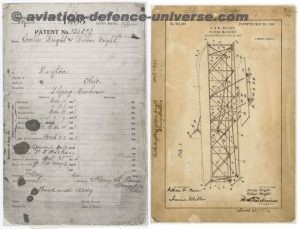
By Sangeeta Saxena
New Delhi. 22 May 2020. Precisely 114 years ago which is not a great span in time, the world saw the recognition of a technology which would become indispensable to mankind and one which human beings could not think of the global skies without . In 1906, the Wright Brothers Wilbur & Orville received a patent for their method of flight control.
Difficult to visualise in 2020 that the aviation industry which is the basis of communication on the earth saw innumerable hurdles in its inception. During their experiments of 1902 the Wrights succeeded in controlling their glider in all three axes of flight: pitch, roll and yaw. Their breakthrough discovery was the simultaneous use of roll control (with wing-warping) and yaw control (with a rear rudder). A forward elevator controlled pitch. In March 1903 they applied for a patent on their method of control. The application, which they wrote themselves, was rejected. In early 1904, they hired Ohio patent attorney Henry Toulmin, and on May 22, 1906, they were granted U.S. Patent 821,393, for a “Flying Machine”. It is a lesser known fact that Wrights had applied for French and German patents on their airplane.
The brothers make practice flights with their new 1904 machine at Huffman Prairie–total flying time is forty-nine minutes. Wilbur makes the first turn in the air on September 15 and the first complete circle on September 20. Longest flight of the year is five minutes four seconds, 23/4 miles–almost four circles around the field. In January 1905 the U.S. Board of Ordnance and Fortification rejects the Wrights’ offer of sale of their airplane. By June 1905 they finished work on a machine and began making flights in it at Huffman Prairie. Wilbur made the longest flight of the year: 24 1/5 miles in 39 minutes, 23 4/5 seconds, more than twenty-nine times around the field, at an average speed of thirty-eight miles per hour in October the same year and the U.S. Board of Ordnance and Fortification declined the Wrights’ second offer of their airplane in the same month. And then came the red letter day in world history when on 22 March 1906 US Patents Office granted them the patent.
And then as always happens the invention of the Wright brothers got a boost when in December 1907 U.S. Signal Corps advertised for bids for a military heavier-than-air flying machine to be submitted by February . Wrights submitted their bid for a heavier-than-air flying machine, weighing between 1,100 and 1,250 pounds, carrying two passengers, and flying at a speed of forty miles per hour which was accepted in February 1908 to furnish a flying machine to U.S. War Department for $25,000 . The rest is history.
The documents were marked as returned in 1980, but a later search failed to locate the patent, and it was added to the official list of missing files. In 2016 after a long hunt it was discovered that the patent had been filed in the wrong box, and that the Archival Recovery Program tracked it down to the March 22 folder in the National Archives storage “cave” in Lenaxa, Kansas.
Information courtesy Library of Congress US



























































































































